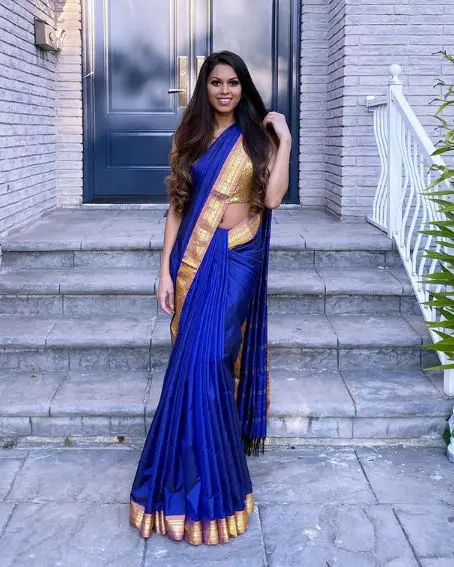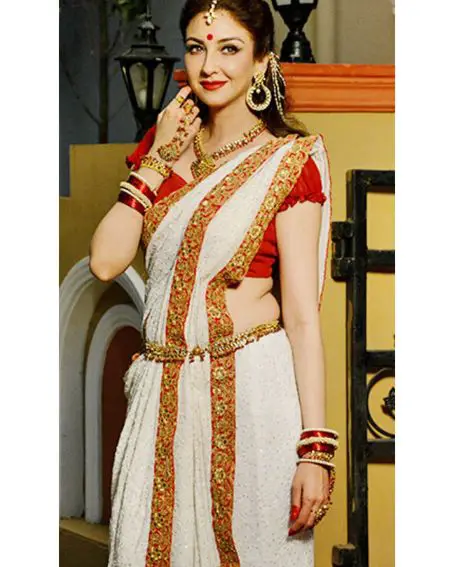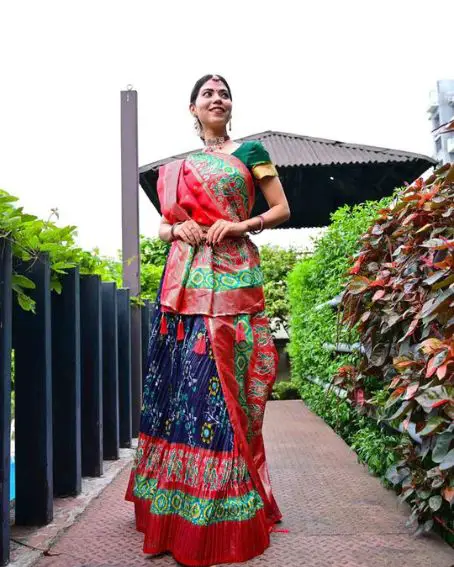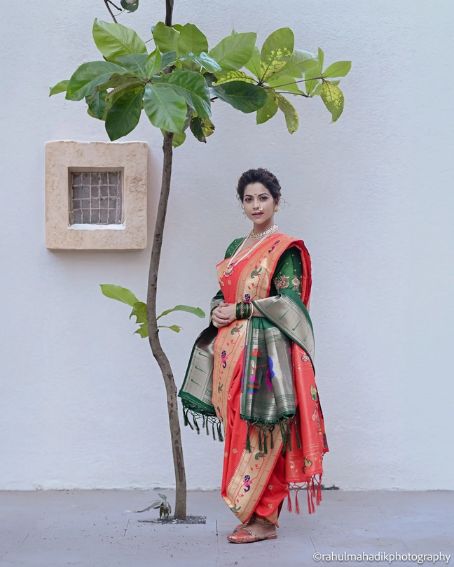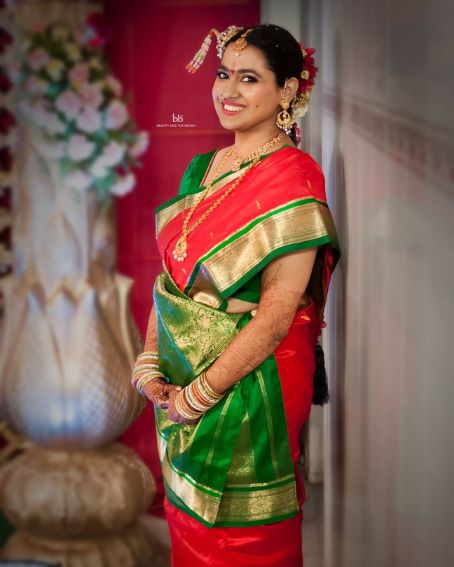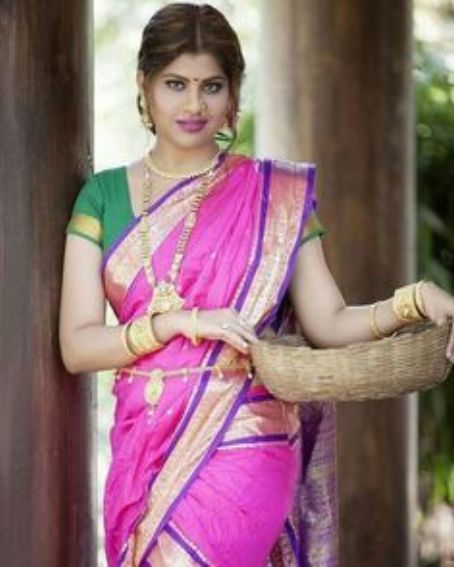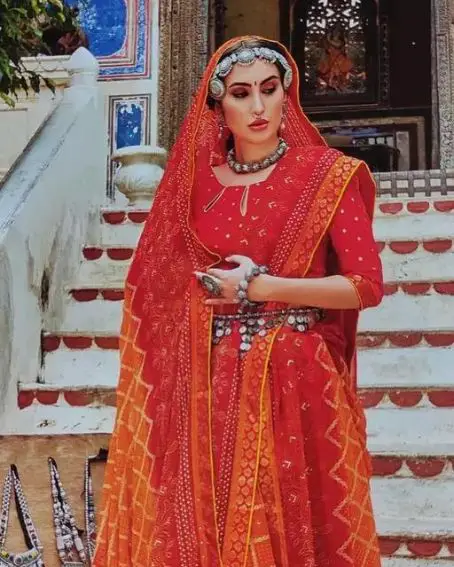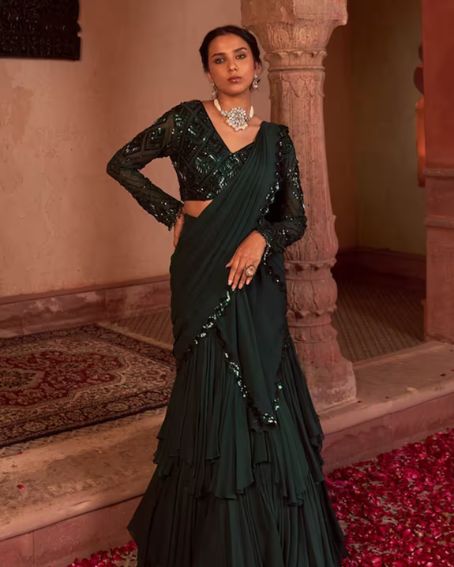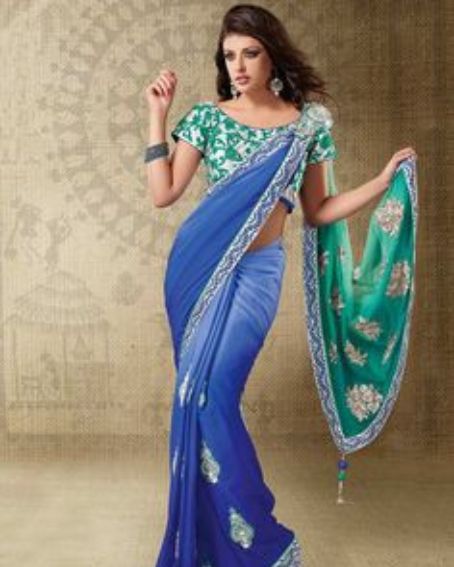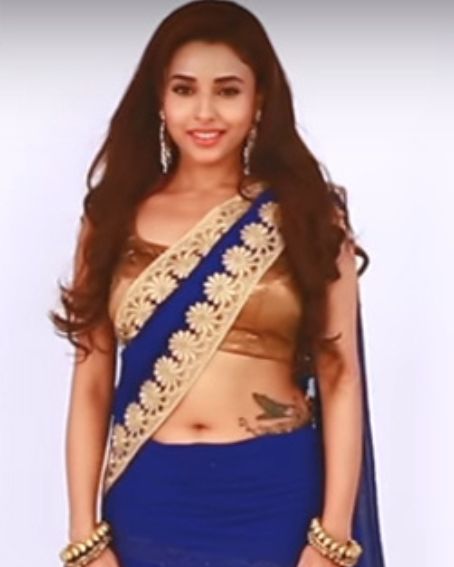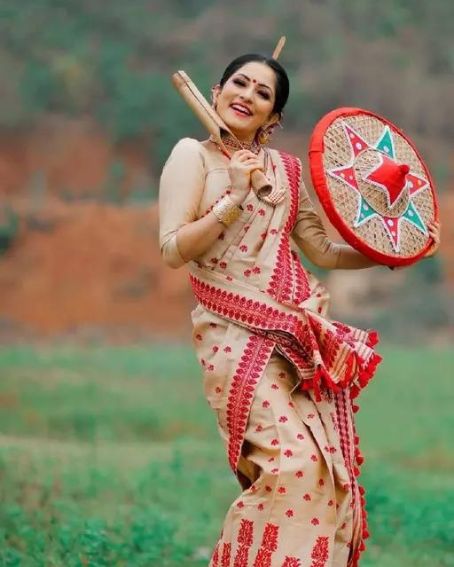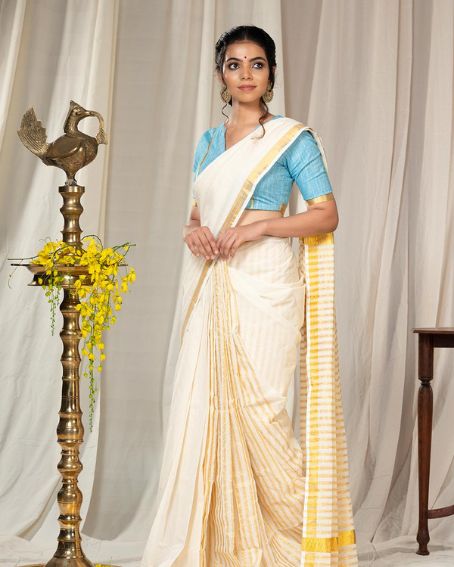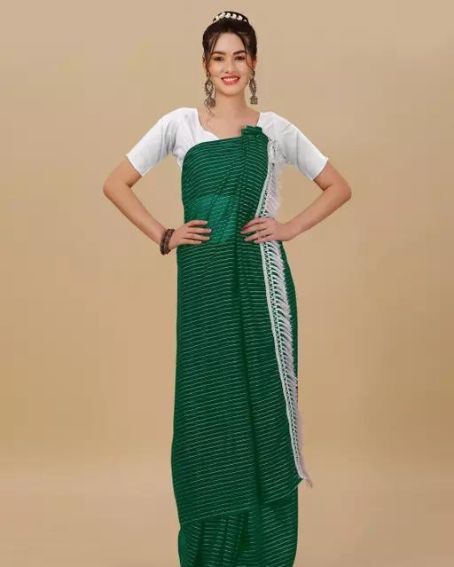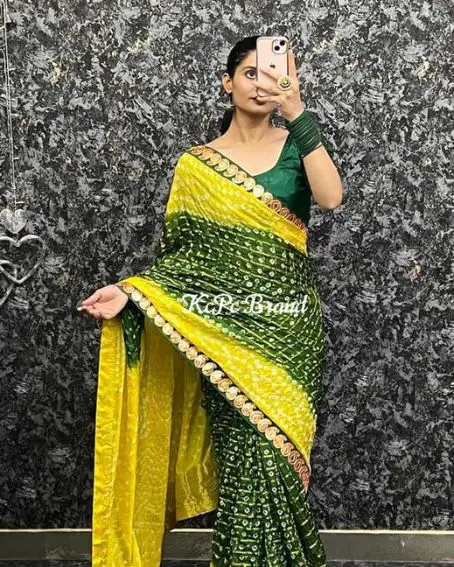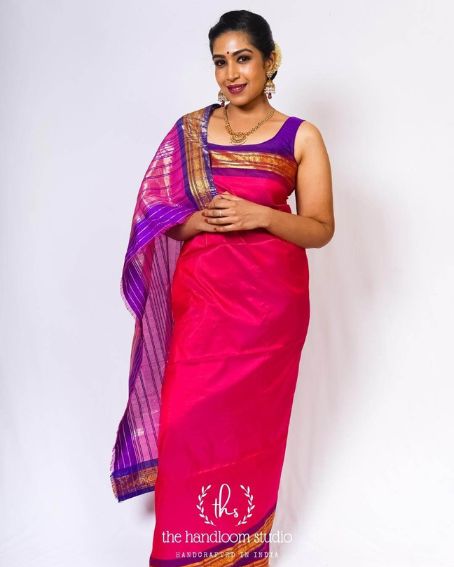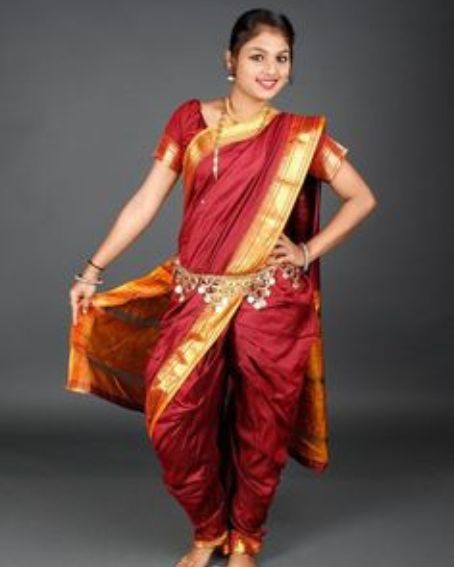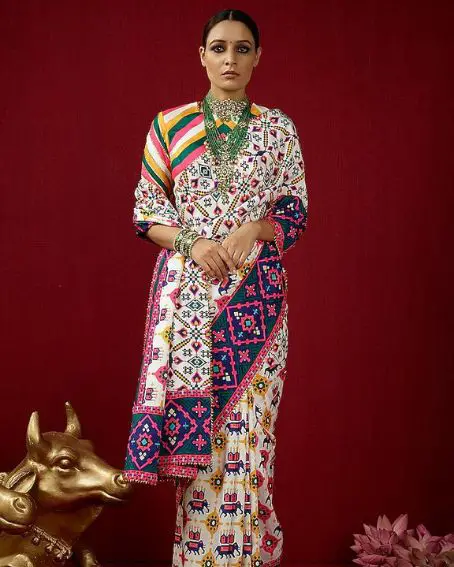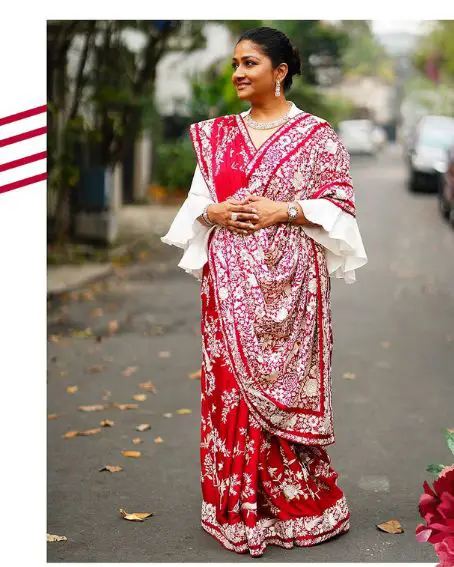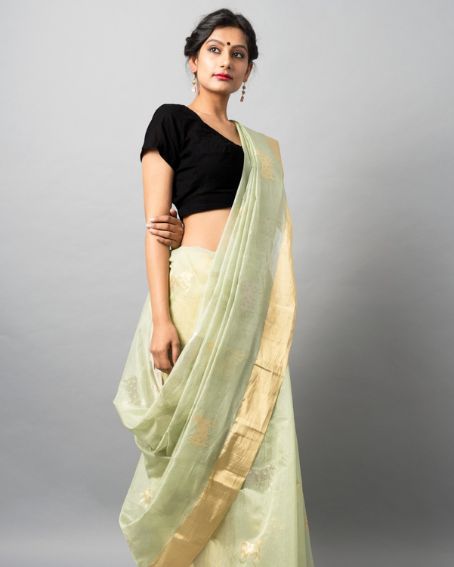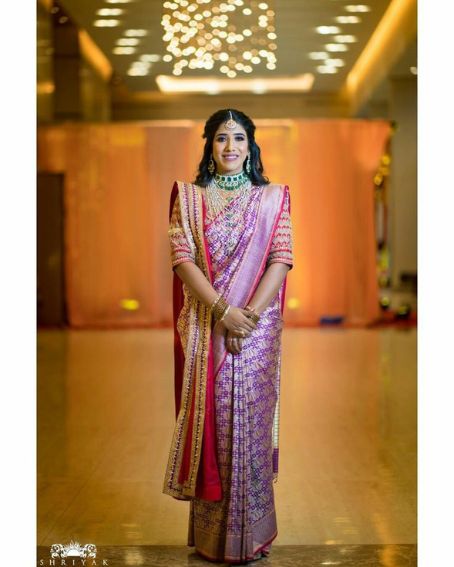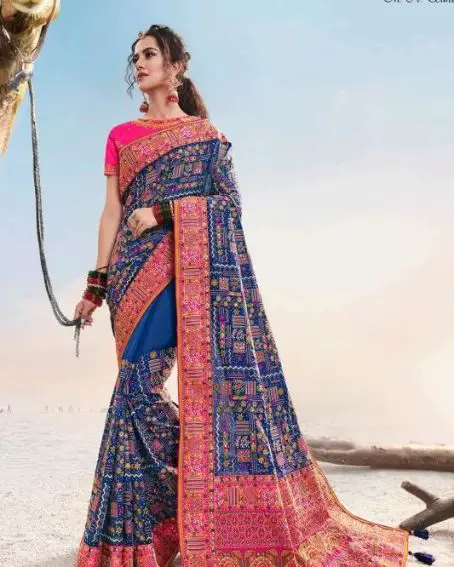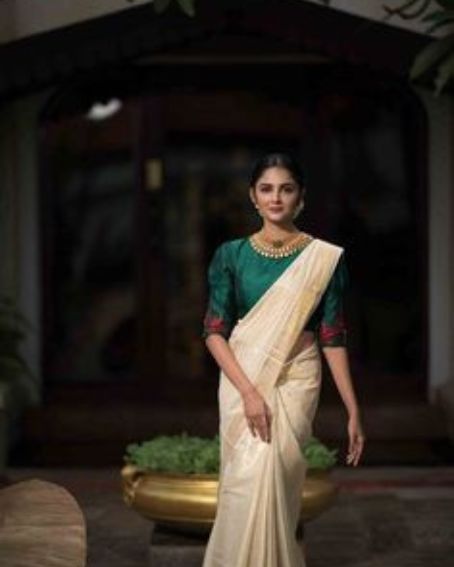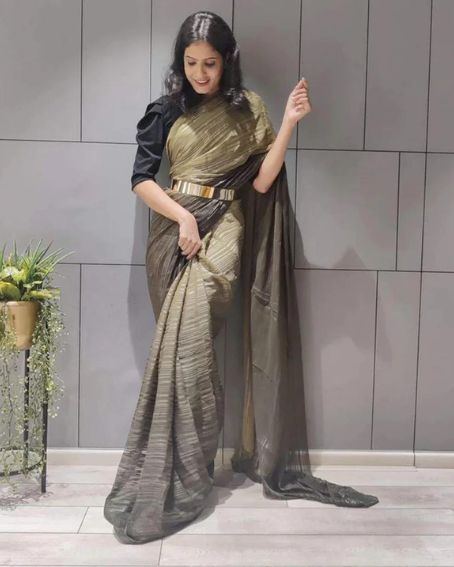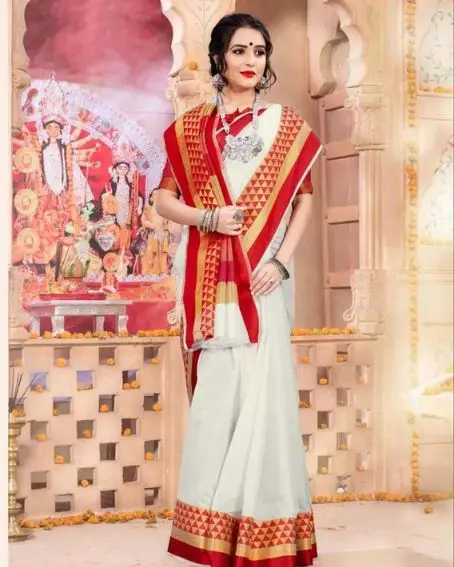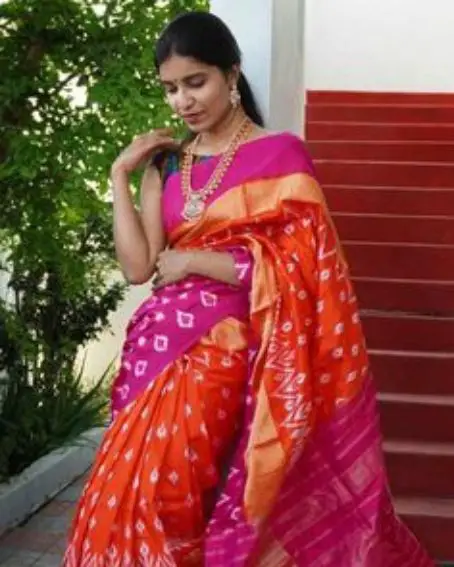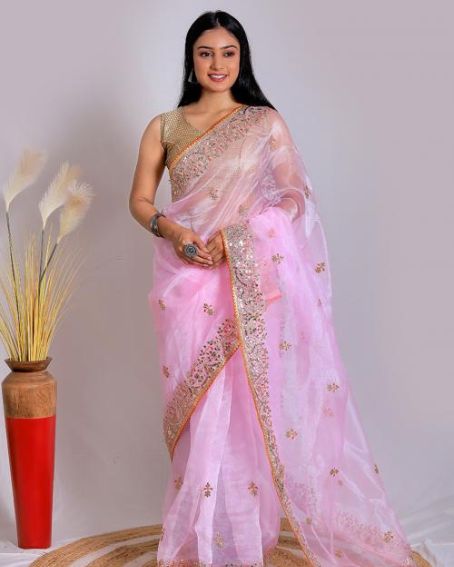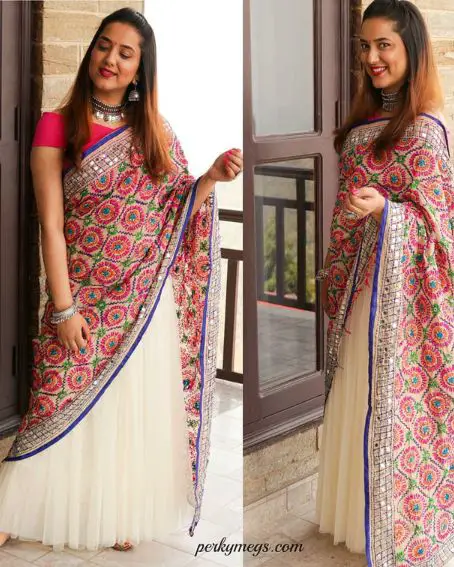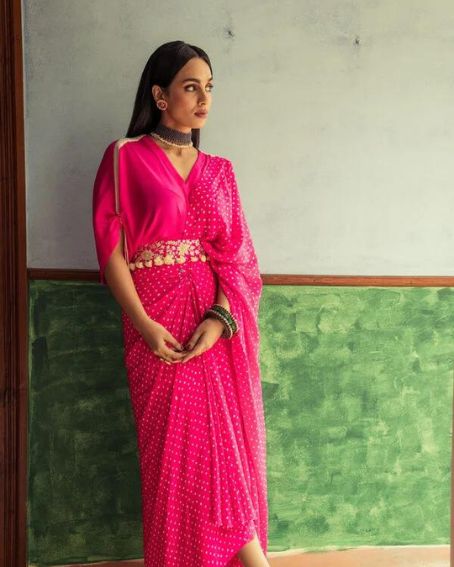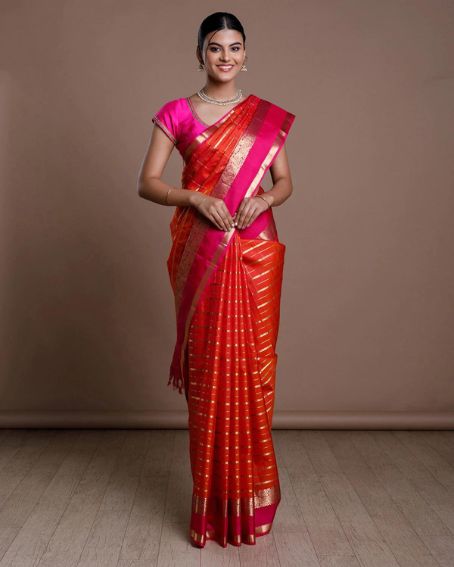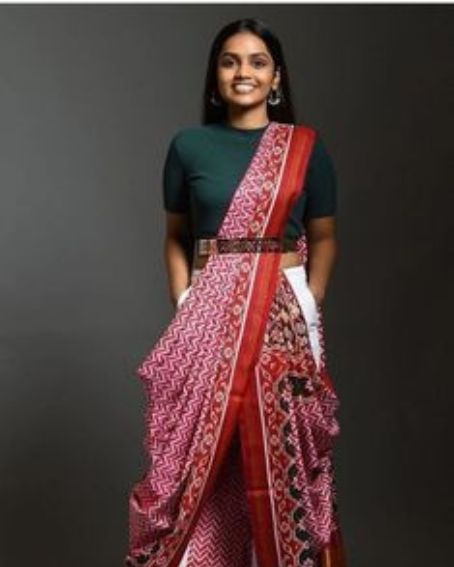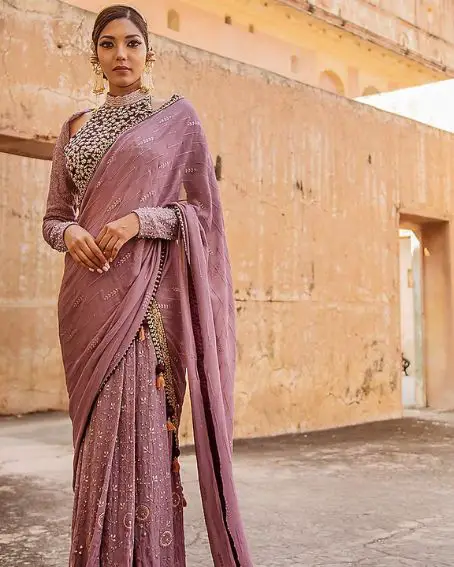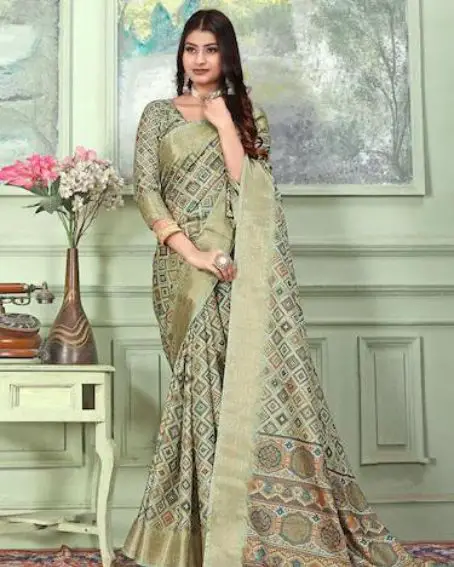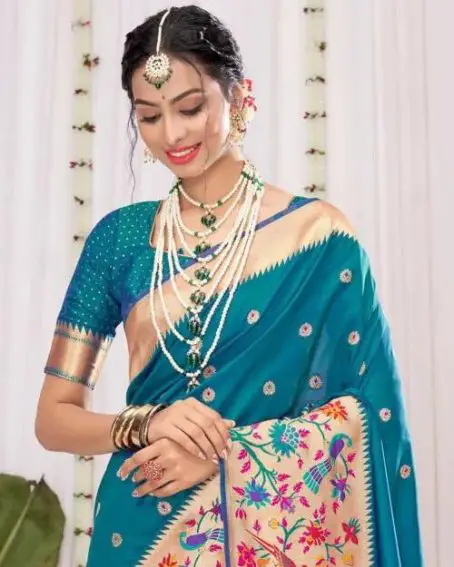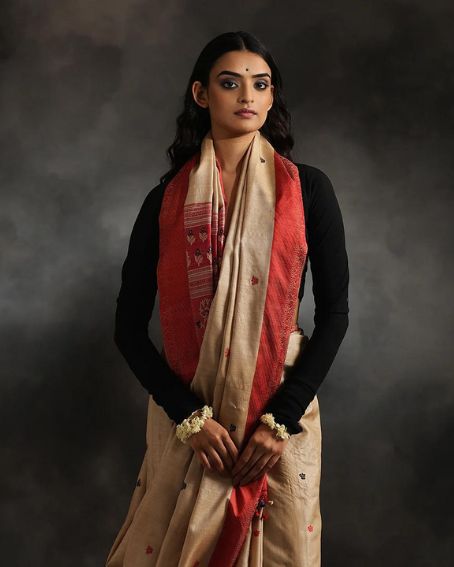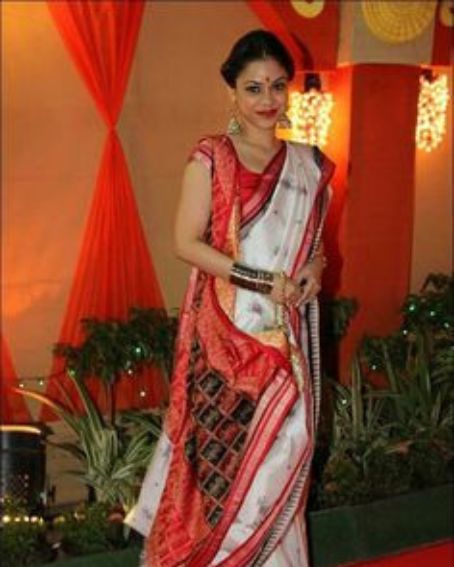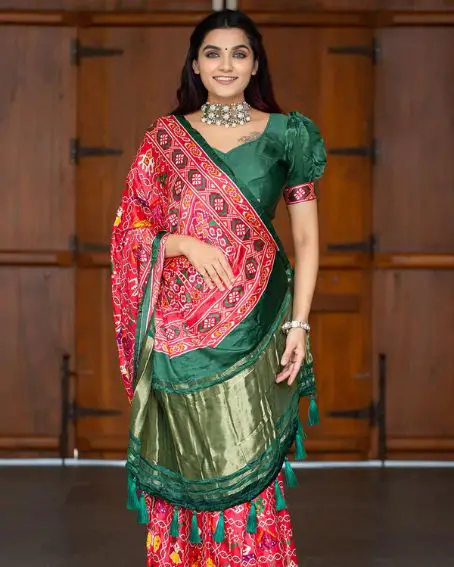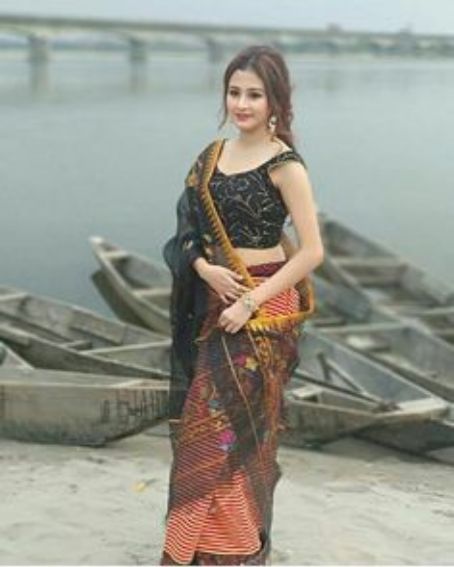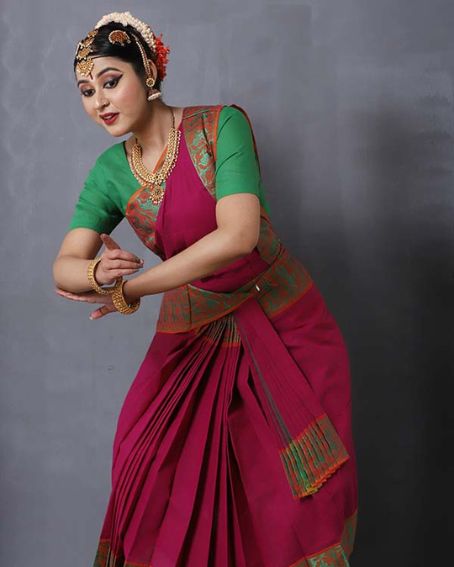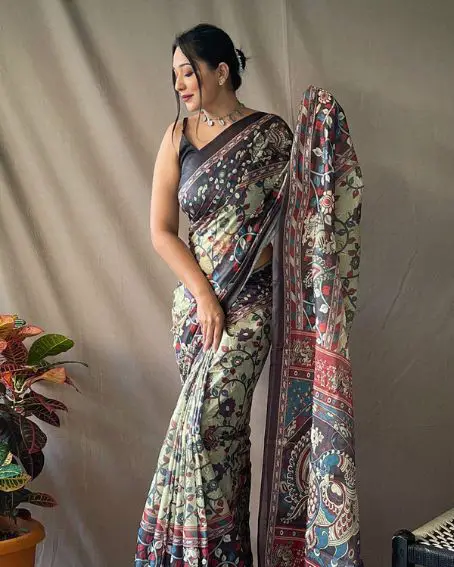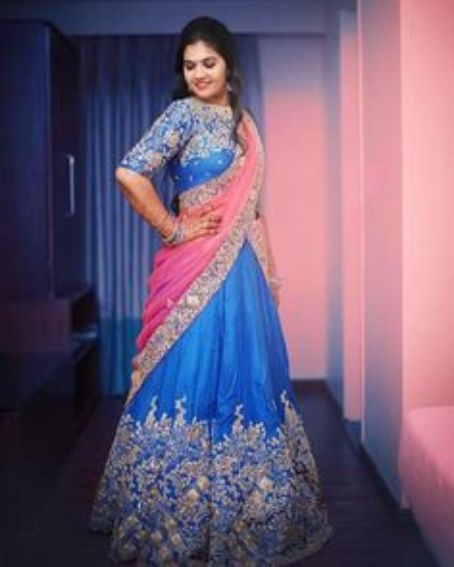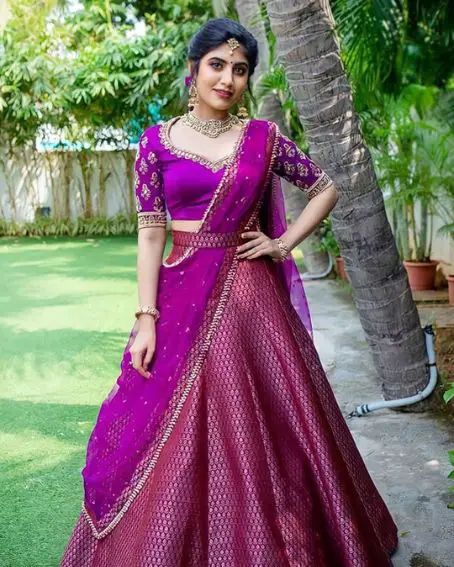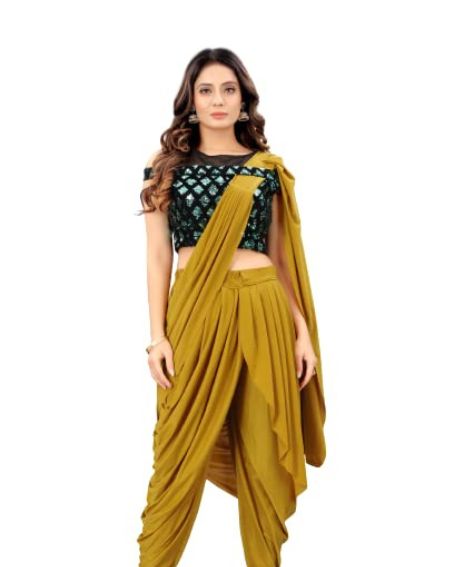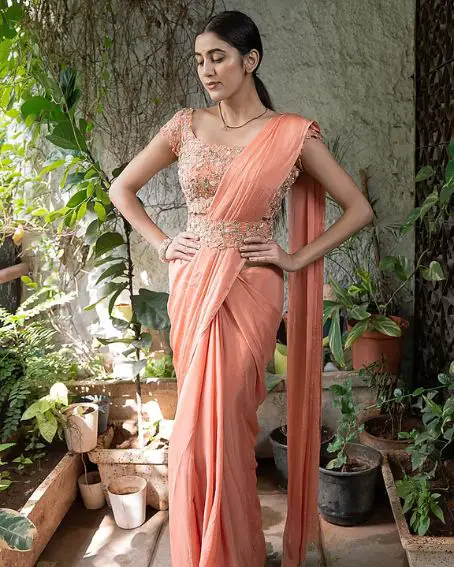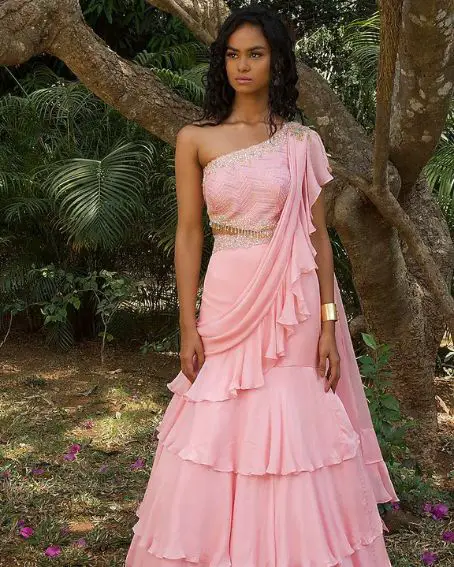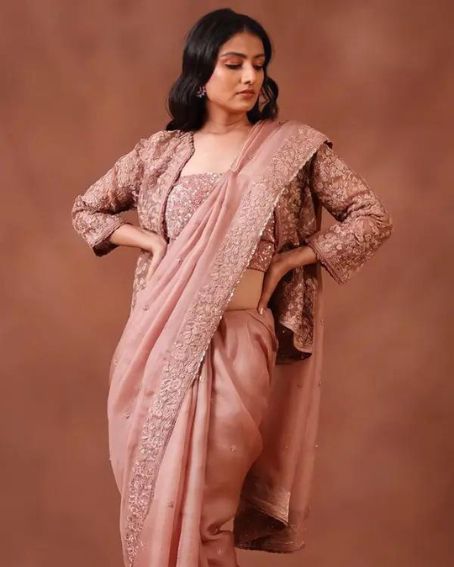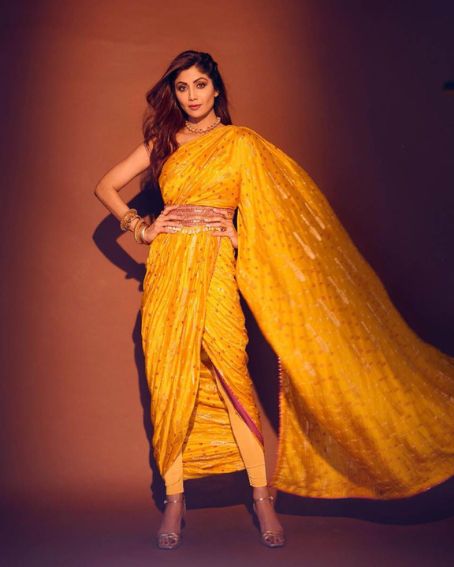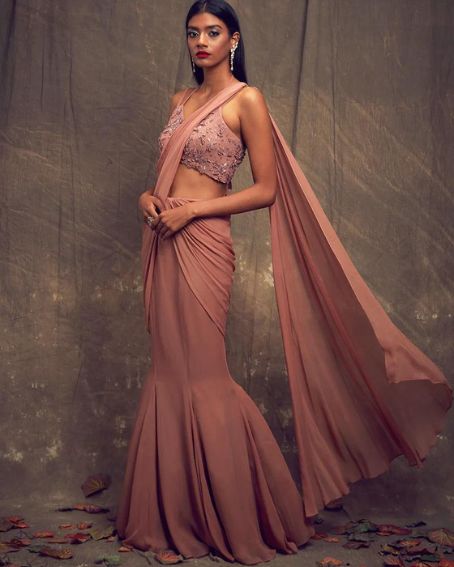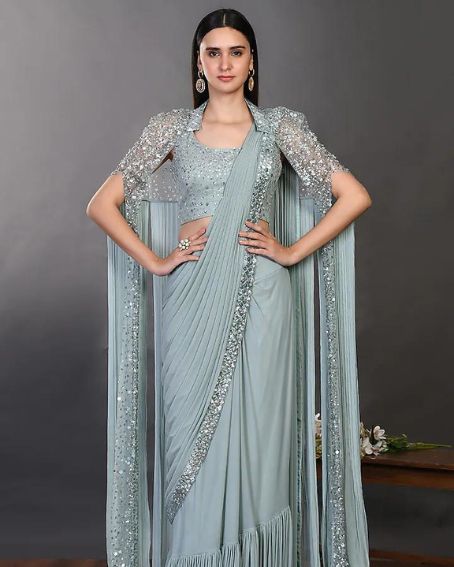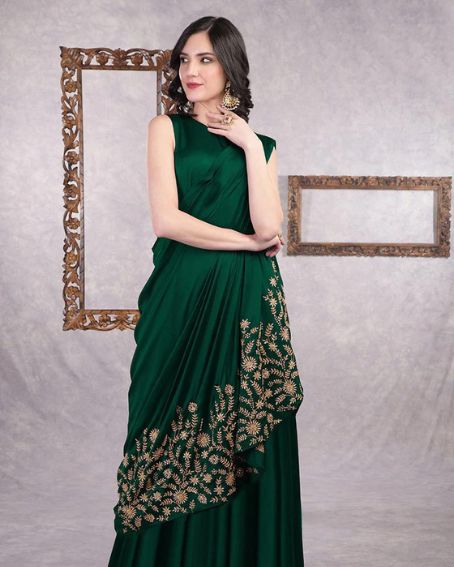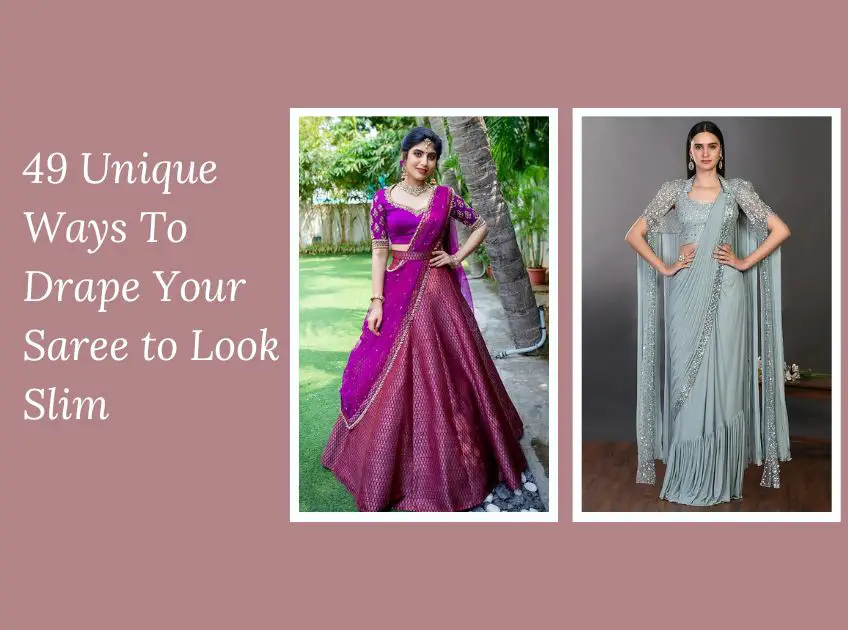
Important: This article is for informational purposes only. Please read our full disclaimer for more details.
Saree draping style refers to the specific way in which a saree, a traditional Indian garment, is worn and arranged on the body. There are numerous draping styles, each with its own techniques and aesthetics, allowing for different looks and variations in how the saree is draped and pleated.
49 Unique Ways To Drape Your Saree to Look Slim
1. Nivi Style
The Nivi style saree drape, popular in Andhra Pradesh, features neatly pleated folds and a pallu worn over the left shoulder. It’s known for its elegant and comfortable look.
2. Bengali Style
The Bengali saree drape showcases a pleated pallu draped from right to left, often adorned with artistic designs and bold borders, reflecting the rich cultural heritage of West Bengal.
3. Gujarati Style
The Gujarati saree drape involves tightly pleated and gracefully flowing fabric, typically with a back pallu, creating a distinctive look with a vibrant color palette and intricate embroidery.
4. Maharashtrian/Nauvari Style
The Nauvari style, from Maharashtra, involves draping the saree with a single nine-yard fabric, providing ease of movement and cultural significance, often seen during traditional Maharashtrian festivities.
5. Tamilian Style
Tamil Nadu’s saree style involves pleating the pallu into a fan shape and draping it over the left shoulder, creating a graceful, yet practical look, well-suited for the hot and humid climate.
6. Kodagu Style
Hailing from Karnataka’s Kodagu region, this drape is characterized by the use of two sarees and distinctive pleating, often worn during festivals and special occasions.
7. Rajasthani Style
The Rajasthani style features vibrant, heavily embroidered sarees draped with multiple pleats and a unique pallu style, reflecting the colorful and regal culture of Rajasthan.
8. Lehenga Saree
Combining the elegance of a saree with the convenience of a lehenga, this style features pre-pleated fabric, making it easy to wear while maintaining a classic Indian look.
9. Butterfly Style
The Butterfly saree drape showcases pallu pleats that resemble butterfly wings, adding a touch of uniqueness to the traditional Indian attire.
10. Mumtaz Style
Inspired by the iconic Bollywood actress Mumtaz, this style features tightly draped pleats and a high pallu drape for a sleek and glamorous look.
11. Mekhela Chador (Assamese)
This Assamese attire consists of a two-piece ensemble, comprising a skirt-like mekhela and a chador draped gracefully over the upper body, reflecting the culture of Assam.
12. Kerala Style (Mundum Neriyathum)
The Kerala saree drape, known as Mundum Neriyathum, involves two pieces of uncut fabric draped elegantly, representing simplicity and grace in the ‘God’s Own Country.’
13. Khasi Style (Meghalaya)
Khasi women from Meghalaya wear a two-piece drape, featuring the jainsem and ryndia, showcasing intricate pleating and colorful patterns that represent their rich tribal culture.
14. Rajputi Poshak (Rajasthan)
The Rajputi Poshak is an opulent ensemble of a saree or skirt paired with a choli, often adorned with intricate embroidery, jewelry, and rich fabrics, symbolizing the grandeur of Rajasthan’s royalty.
15. Coorgi Style
Coorgi saree drape reflects the rich heritage of Coorg in Karnataka. It features a distinctive pleat at the back and a pallu that drapes elegantly over the shoulder.
16. Tribal Drapes (Various regions)
Tribal drapes vary across India’s diverse tribal communities. They often feature unique weaving techniques, patterns, and colors that showcase the culture and identity of these groups.
17. Mysore Silk Saree Drape
The Mysore silk saree drape is characterized by its exquisite silk fabric and minimalistic pleating. It offers a regal and classic look, perfect for traditional occasions.
18. Parsi Gara Drape
Parsi Gara saree drapes come from the Parsi community, known for their intricate embroidery. These drapes feature delicate motifs and a distinctive style, reflecting Parsi culture.
19. Chanderi Saree Drape
Chanderi saree drapes hail from Madhya Pradesh and are celebrated for their lightweight texture and fine handwoven patterns. They offer an elegant and graceful appearance.
20. Banarasi Saree Drape
Banarasi saree drapes are famous for their opulent silk and brocade work. They are often draped with rich pleats and a heavy pallu, ideal for weddings and grand occasions.
21. Kutch Embroidery Saree Drape
Kutchi embroidery saree drapes showcase the intricate hand-embroidery of the Kutch region in Gujarat. These drapes are colorful and vibrant, reflecting the local craft traditions.
22. Kasavu Saree Drape (Kerala)
The Kasavu saree drape from Kerala features a distinctive off-white fabric with a golden zari border. It exudes simplicity and grace, often worn for cultural events.
23. Chiffon Saree Drape
Chiffon saree drapes are known for their light and airy feel. They offer a soft, flowing appearance, making them a popular choice for formal gatherings and parties.
24. Tant Saree Drape (Bengal)
Tant saree drapes originate from West Bengal and are known for their crisp cotton texture and intricate patterns. They provide a comfortable and traditional look.
25. Pochampally Ikat Saree Drape (Telangana)
Pochampally Ikat saree drapes are crafted with tie-dye and weaving techniques. They feature bold, geometric patterns, giving a vibrant and contemporary look.
26. Gota Patti Saree Drape (Rajasthan)
Gota Patti saree drapes from Rajasthan showcase the use of golden gota (ribbon) work. These drapes are richly adorned and are commonly worn during celebrations and festivals.
27. Phulkari Saree Drape (Punjab)
Phulkari saree drapes hail from Punjab and feature colorful floral embroidery. They are vibrant and exude a lively, traditional Punjabi spirit, ideal for festive occasions.
28. Bandhani Saree Drape (Gujarat/Rajasthan)
Bandhani saree drapes are known for their tie-dye patterns. They offer a bright and cheerful appearance, making them suitable for cultural celebrations and gatherings.
29. Kanjeevaram Saree Drape (Tamil Nadu)
Kanjeevaram saree drapes are crafted from luxurious silk with distinctive zari work. They are renowned for their opulence and are the epitome of South Indian elegance.
30. Patola Saree Drape (Gujarat)
Patola saree drapes originate from Patan in Gujarat. They are characterized by their double ikat weave and rich colors, making them a symbol of heritage and tradition.
31. Chikankari Saree Drape (Lucknow)
Chikankari saree drapes from Lucknow feature intricate white-on-white embroidery. They offer a delicate and graceful appearance, often worn on formal occasions.
32. Tussar Silk Saree Drape
Tussar silk saree drapes showcase the natural texture of Tussar silk. They provide an elegant and timeless look, suitable for various cultural events.
33. Paithani Saree Drape (Maharashtra)
Paithani saree drapes from Maharashtra are known for their vivid colors and peacock motifs. They are a symbol of Maharashtrian culture and are often worn during festivals.
34. Jamdani Saree Drape (Bengal)
Jamdani saree drapes from Bengal are distinguished by their fine muslin fabric and intricate handwoven patterns. They exude a blend of tradition and sophistication.
35. Sambalpuri Saree Drape (Odisha)
Sambalpuri saree drapes from Odisha feature unique tie-dye and ikat weaving techniques. They showcase a mix of vibrant colors and indigenous designs, perfect for cultural events.
36. Gajji Silk Saree Drape (Gujarat)
Gajji silk saree drapes from Gujarat feature rich, vibrant colors and intricate patterns. The heavy silk fabric provides a regal and traditional appearance.
37. Manipuri Saree Drape (Manipur)
Manipuri saree drapes from Manipur highlight the state’s unique handwoven textiles. They often feature bright hues and are wrapped in distinctive regional styles.
38. Kathak Dancers Saree Drape
Kathak dancers’ saree drapes are designed for ease of movement. They involve a secure yet graceful style that complements the intricate footwork and spins of the dance form.
39. Kalamkari Saree Drape (Andhra Pradesh)
Kalamkari saree drapes showcase hand-painted or block-printed motifs on the fabric. They are known for their artistic flair and are often worn for cultural events.
40. Nivi Lehenga Style
Nivi lehenga style saree drapes offer the elegance of a lehenga with the convenience of a saree. Pleats are neatly arranged, giving a royal and contemporary appearance.
41. Half Saree Style
Half saree style drapes are a blend of tradition and modernity. They involve a distinct drape with pleats and a pallu, often worn by young girls during celebrations.
42. Dhoti Style Saree Drape
Dhoti style saree drapes are inspired by the traditional Indian dhoti. The pallu is intricately wrapped around to resemble a dhoti, offering a unique and stylish look.
43. Saree with Belt
Saree with a belt is a contemporary twist to traditional draping. A belt cinches the saree at the waist, adding a touch of sophistication and helping secure the pleats.
44. Saree Gown
Saree gowns combine the beauty of a saree with the ease of a gown. They are pre-stitched, making it convenient to wear while preserving the saree’s elegance.
45. Jacket Style Saree Drape
Jacket style saree drapes involve pairing a jacket or blazer with a saree. This fusion offers a modern, stylish, and elegant look, often seen in weddings and events.
46. Saree with Pants
Saree with pants, a trendy choice, combines a saree with fitted pants. It offers comfort and contemporary flair while maintaining the traditional drape’s essence.
47. Mermaid Style Saree Drape
The mermaid style saree drape mimics the silhouette of a mermaid tail. It involves tightly pleated lower portions and a flaring pallu, creating a unique and alluring appearance.
48. Saree with Cape
Saree with a cape adds a fashionable layer to the traditional attire. The cape can be plain or embellished, providing a chic and trendy look.
49. Saree with Toga
Saree with toga is a fusion of a toga-style blouse and saree draping. It offers a contemporary and minimalist look, ideal for modern fashion-forward individuals.
Conclusion
India’s rich cultural diversity is beautifully reflected in the diverse saree draping styles found across the country. Each region has its unique tradition and technique, showcasing the unity in diversity. From Andhra Pradesh’s intricate Nivi style to the graceful Gujarati drape and the elegant Bengali draping method, each style holds its own charm and significance. These styles combine aesthetics with practicality, offering comfort tailored to the varying environmental conditions across India.
Related Articles
- Skirt For Haldi Ceremony – Brides Sister Dresses 20 Ideas
- 15 Different Types of Fashion Belts for Women
- Different Types Of Women’s Pants With Names – Top 24
- Types of Dresses Every Woman Should Know – top 17
- 14 Popular Types of Sleeves Design Pattern Ideas
